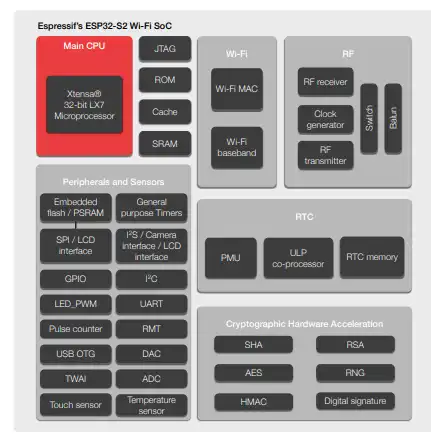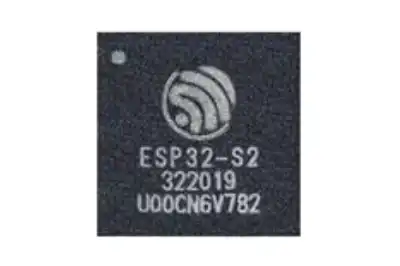The ESP32-S2 SoC is a high-performance microcontroller developed by Espressif Systems, specifically designed for Internet of Things (IoT) applications.
The ESP32 is one of the variants of the ESP32 family. In short, the ESP32-S2 is a single-core variant, without Bluetooth, suitable for low-power and low-cost applications.
The ESP32-S2 is equipped with a single-core RISC-V Xtensa LX7 processor, which operates at speeds of up to 240 MHz. It also features a floating-point unit (FPU) for precise and accelerated mathematical calculations.
This processor architecture provides an optimal balance between performance and power consumption, making it an efficient choice for IoT applications with low power requirements.
The ESP32-S2 SoC offers flexible memory and storage options. It has 320 KB of internal SRAM and supports the use of external memory via SPI or QSPI interfaces.
Regarding flash storage, the ESP32-S2 SoC offers up to 128 MB of flash memory, allowing for the storage of firmware, data, and additional application files.

In terms of connectivity, the ESP32-S2 retains the characteristic Wi-Fi of the ESP32 series. It supports the Wi-Fi 802.11b/g/n standard, ensuring a stable and reliable connection.
However, as we have already mentioned, the ESP32-S2 lacks Bluetooth. Keep this in mind if you choose this particular model, so you won’t be surprised.
Regarding peripherals, the ESP32-S2 has a wide range of interfaces. These include UART, SPI, I2C, I2S, and PWM, allowing communication with sensors, displays, actuators, and other devices.
Additionally, it also includes a 12-bit ADC for precise conversion of analog signals, and an 8-bit DAC.
In terms of security, the ESP32-S2 features a variety of advanced capabilities, such as support for AES, SSL/TLS, and RSA cryptography, ensuring the protection of transmitted data. It also includes a hardware random number generator (RNG) for generating secure cryptographic keys and values.
ESP32-S2 Features
Here is a summary of some of its features.
CPU and memory
- Xtensa® single-core 32-bit LX7 microprocessor, up to 240 MHz
- 128 KB ROM, 320 KB SRAM
- 16 KB SRAM in RTC
- SPI/QSPI/OSPI supports multiple flash and external RAM chips
Peripherals
- 43 × GPIOs
- 2 × 13-bit SAR ADCs, up to 20 channels
- 2 × 8-bit DAC
- 14 × touch sensing IOs
- 4 × SPI, 1 × I2S, 2 × I2C, 2 × UART, RMT (TX/RX)
- LED PWM controller, up to 8 channels
- 1 × full-speed USB OTG
- 1 × temperature sensor
Wi-Fi
- IEEE 802.11 b/g/n-compliant
- Supports 20 MHz, 40 MHz bandwidth in 2.4
Security
- Secure boot, Flash encryption
- Cryptographic hardware acceleration, AES-128/192/256, RSA, Random Number Generator (RNG), HMAC, Digital signature
